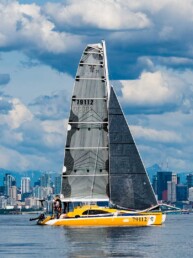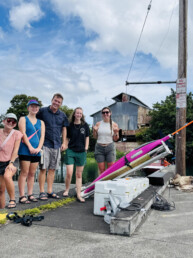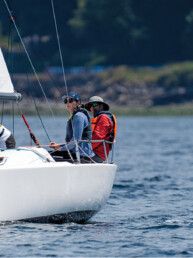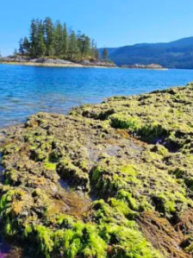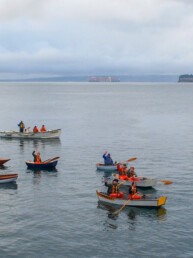In our latest destinations installment courtesy of SalishSeaPilot.com‘s Jim Burgoyne, we take an in-depth look at cruising up magnificent Princess Louisa Inlet.
Sitting in the cockpit and looking up at the mountain walls soaring above Chatterbox Falls, there are no words. None.
It might be true that there is nowhere on the Sunshine Coast, or anywhere along the Pacific coast for that matter, that is more captivating, more stunningly beautiful than Princess Louisa Inlet.
But it’s hard to find an adjective that hasn’t already been used many times before, including a few epithets by yours truly. It’s enough to say that visiting Princess Louisa is an experience, an adventure, magically and majestically set.
So, I won’t gush. Rather, I will just offer a tip or two to make the adventure simpler for those who haven’t yet been.
The downside of a voyage here is the long, 40-nautical-mile detour up Jervis Inlet, from Ballet Bay off Georgia Strait to Malibu Rapids at the entrance to Princess Louisa.

However, anchorages and marinas along the way provide good shelter and cut a good chunk from the distance, allowing boaters to make the trip in two or more days.
In Skookumchuck Narrows, there’s Backeddy Marina, with transient moorage, easy ties and an excellent pub-restaurant. It is 30nm from Malibu Rapids.
A little farther along, a half mile southeast, is the government dock at Egmont where there is typically openings for transients as long as you are willing to raft. Here, you arrive, tie up and leave your funds in the dock box, rarely having to deal with a human being.
To the north, in Hotham Sound are the Harmony Islands. This popular group, 32nm from Princess Louisa Inlet, offers decent anchorage in most conditions. About 1-2nm farther are the anchorages along the west shore of the sound which are well protected from westerlies.
Dark Cove, which also provides good cover, is north around the corner from both Hotham Sound and Skookumchuck Narrows, trimming the distance to Princess Louisa to 27nm.
The trip up Jervis Inlet can be pleasant, and sailors will attest that riding a gentle inflow breeze is like a dream, though pounding mile after mile into an outflow has filled many log passages with molten expletives and broken pencil tips. It pays to heed weather forecasts, though there are times when predicted flows, in or out, are more boisterous than forecast.
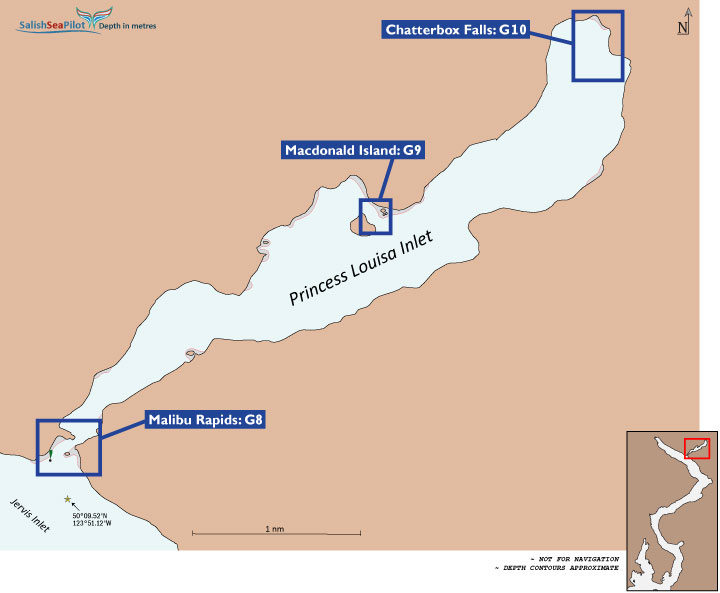 Or less so. Those same Environment Canada VHF forecasts take in a large area and tend to focus on the worst weather predicted within that area. Often the forecast will be brutal, while your experience will be calm winds, clear skies and flat seas.
Or less so. Those same Environment Canada VHF forecasts take in a large area and tend to focus on the worst weather predicted within that area. Often the forecast will be brutal, while your experience will be calm winds, clear skies and flat seas.
Or williwaws, which do not seem to be included in VHF forecasts. They can blow down the mountainsides in Jervis Inlet with little forewarning.
Our experience typically, not exclusively, has been that inflows are gentler in the morning, building through the day. Of course, that might not lend itself to reaching and transiting Malibu Rapids at a convenient time.

Once at the rapids, a key to a successful transit is to not rely on the accuracy of PC-based tide apps which use the public domain software “harmonic.idx”. They are dead wrong at Malibu Rapids. The reason is beyond my pay grade.
You will also note that some well-regarded mobile navigation software, such as Navionics, which provides current information for most passes in the Salish Sea, does not have current or tidal information for Malibu Rapids.
Instead, use the Canadian Hydrographic Service tide tables for Point Atkinson. Slack water in Malibu Rapids is 25 minutes after high water and 35 minutes after low water at Point Atkinson.
The tide and current tables can be downloaded free from Fisheries and Oceans Canada (Vol. 5, Juan de Fuca Strait and Strait of Georgia). The guides use Pacific Standard Time, not daylight time, so add an hour during the summer.
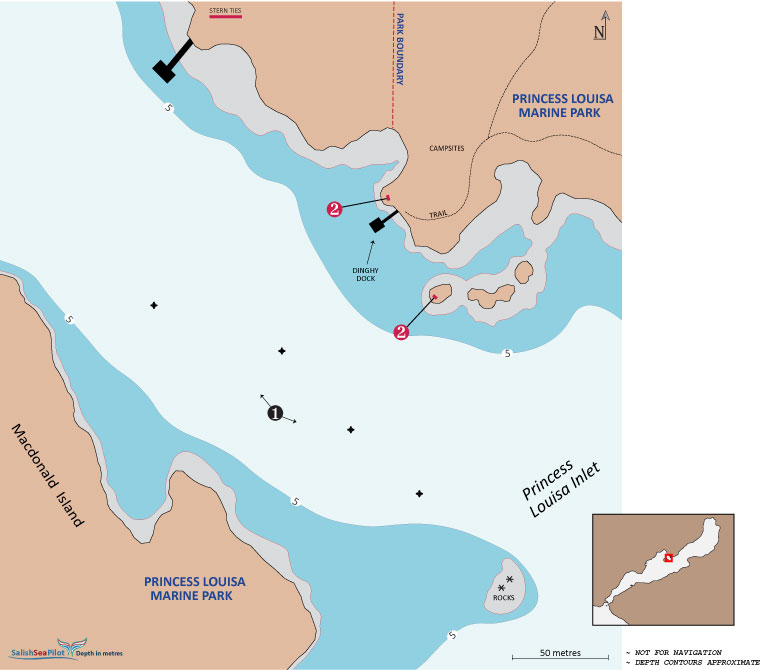
Monitor VHF 16. Before entering the rapids, radio your identity and direction. It can be perilous for two large vessels to meet in the channel. Note there is no cell coverage here.
When several boats are preparing to transit the rapids, inbound or out, it is nautical etiquette for the first vessel through to communicate to those behind if there are boats on the other side waiting to come through.

Once safely inside, Macdonald Island is about 2nm along, or half way to the head of the inlet. Here there are mooring buoys, stern tie rings and park trails ashore. If the inlet appears to be busy, as it can be in the summer, we often take a mooring here if available before relocating to the head of the inlet the next day.
Deeper into the inlet are the views for which Princess Louisa is famous, including Chatterbox Falls and rock walls that reach skyward.
 Here there is the park dock, new mooring buoys, various stern tie rings, as well as anchorage for one or two vessels in front of the falls.
Here there is the park dock, new mooring buoys, various stern tie rings, as well as anchorage for one or two vessels in front of the falls.
Departing Princess Louisa, where conditions are often icily still, boaters can sometimes find in the late morning or early afternoon surprisingly strong winds blowing outside in much larger Jervis Inlet. The options for boaters can then seem to be limited to turning around and re-entering Princess Louisa to find shelter, or pound for hours in wind and waves to make their way south.
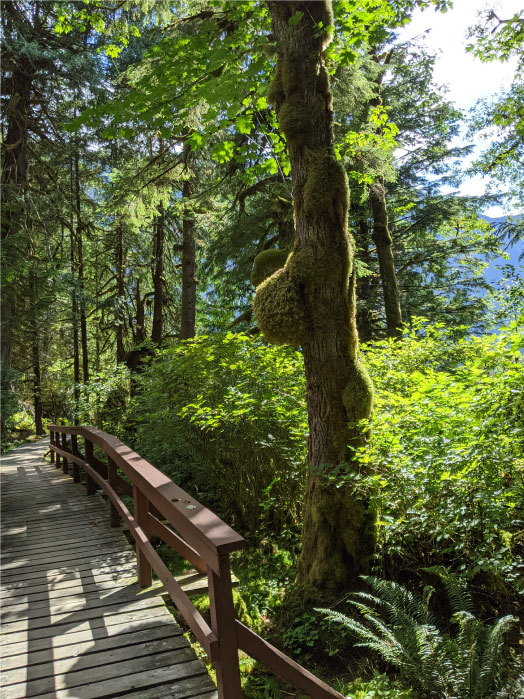
However, another option includes an anchorage across the inlet, northwest of Patrick Point. The bight offers good protection from southerlies, especially for vessels rigged to take a stern tie to shore.
Every boater should visit Princess Louisa at least once. Those prepared to take their time and heed weather forecasts will take away nothing but special memories.
Note: This article was originally published on SalishSeaPilot.com. The 2023 versions of Salish Sea Pilot’s cruising guides are available now.

